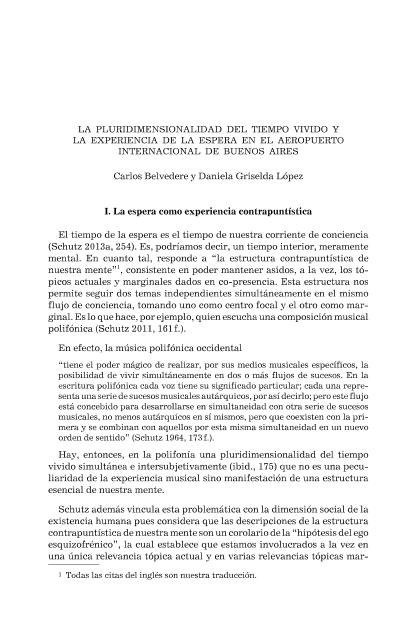Artículo
Durante los años 2014 y 2015 se llevó a cabo una investigación5 en el Aeropuerto Internacional Ministro Pistarini de la ciudad de Ezeiza, Provincia de Buenos Aires, Argentina. Con el objetivo de explorar el fenómeno de la espera como una construcción socio-cultural, el proyecto se propuso abordar eltema más general del manejo cultural del tiempo. Para ello se realizaron entrevistas en profundidad a expertos que tratan profesionalmente con las personas que esperan y a especialistas en el diseño, planificación y gestión de las áreas de espera. También se hicieron entrevistas cortas a pasajeros que esperaban próximos a abordar su vuelo en el área de pre-embarque. ¿Cuál es la interpretación que estos entrevistados le asignan a las situaciones de espera? Y,¿cuáles son los patrones de percepción y acción de los pasajeros que esperan con referencia al tiempo y al espacio? Estos fueron algunos de los interrogantes que articularon las entrevistas realizadas. Más en detalle, se realizaron dos entrevistas semi-estructuradas con expertos en el planeamiento, diseño y gestión de espacios de espera y cuatro entrevistas informales con coordinadores de distintas áreas del Aeropuerto Internacional Ministro Pistarini. Asimismo, durante cuatro jornadas, se realizaron observaciones etnográficas y se tomaron fotografías de todos los espacios relevantes señalados por los expertos. Esta reconstrucción visual se completó con la recopilación de materiales vinculados a las áreas de espera previas a su remodelación iniciada en el año 2000: fotografías, planos, y antiguas publicidades. Por último, se entrevistó a cincuenta y tres pasajeros en el área de pre-embarque del aeropuerto los días 3, 4 y 5 de agosto de 2015. Deseamos agradecer al ORSNA y a su presidente, el Dr. Gustavo Lipovich, por facilitar la gestión de los permisos para el ingreso al Aeropuerto. Agradecemos también a Gustavo D’Antiochia, docente de la Universidad Provincial de Ezeiza, y al arquitecto Gerardo Pucciarello (Aeropuertos Argentina 2000) por sus valiosos aportes This paper aims to disclose that waiting is, as stated by Alfred Schutz, a phenomenon in our durée (or inner duration) which deals with several streams of consciousness at the same time grasped together by the contrapuntal structure of our mind. Based on empirical research conducted at the international airport of Buenos Aires Ministro Pistarini we argue that the organization of the time of waiting produced by experts explicitly plays with the contrapuntal structure of the mind in order to hold together at once the topic of the process of boarding, aiming to take the plane, and the topic of activities that entertain the passengers while waiting. This involves an inversion of the passenger’s hierarchy of relevancies, who moves from the experience of just waiting to the ecstatic experience of consumption.In order to setin a durable way this structuration ofthe thematic kernel and the hierarchy of relevancies, experts seek to incentivize the development of habitualities and automatisms. This is generally achieved except when unforeseen events come up or passengers resist the strategies of incentive to consummation and the demarcation of exclusive places in the airport. Also, even if the time of waiting is often seen as normal, habitual and according to international standards, when operational contingencies occur and processes become slower than expected, the experience of waiting gets once again the center of attention and it can produce anxiety when the original structure of relevancies, in which waiting takes the first place, is reset and becomes the thematic kernel. Zweck dieser Studie ist es zu zeigen, dass Warten, wie Alfred Schütz feststellt, ein Phänomen in unser „durée“ (oder auch „inneren“ Zeit) ist, das mehrere Bewusstseinsströme gleichzeitig umfasst, die vom kontrapunktischen Aufbau unseres Bewusstseins zusammengehalten werden. Auf der Basis einer empirischen Forschung am Flughafen Ministro Pistarini in Buenos Aires argumentieren wir, dass die von Experten organisierte Zeit des Wartens explizit mit dem kontrapunktischen Aufbau unseres Bewusstseins spielt, um das Thema des BoardingProzesses und das Thema der Aktivitäten, die die Fluggäste während des Wartens unterhalten, zusammenzuhalten. Dies erfordert eine Umkehr der RelevanzHierarchien der Fluggäste, die zwischen dem Erlebnis des Wartens und „ekstatischer“ Konsumerfahrung pendeln. Um die gewünschte Ordnung von thematischem Kern und Relevanz-Hierarchien dauerhaft etablieren zu können, suchen die Experten, die Entwicklung von Gewohnheiten und Automatismen zu fördern. Dieses Ziel wird im Allgemeinen erreicht, außer wenn unvorhergesehene Ereignisse eintreten oder wenn die Fluggäste der Stimulierung zum Konsum widerstehen und sich nicht an die Abgrenzung exklusiver Orte am Flughafen halten. Auch wenn die Wartezeit als normal, gewöhnlich und internationalen Standards entsprechend wahrgenommen wird, kann die Erfahrung des Wartens ins Zentrum der Aufmerksamkeit rücken, wenn operationale Probleme auftreten und die Prozesse langsamer ablaufen als erwartet. Wenn der ursprüngliche Relevanz-Aufbau wieder einsetzt, in dem das Warten an erster Stelle steht, wird es zum thematischen Kern und kann in der Folge Sorge erzeugen.
La pluridimensionalidad del tiempo vivido y la experiencia de la espera en el aeropuerto internacional de Buenos Aires
Fecha de publicación:
12/2016
Editorial:
Dunckler & Humblot
Revista:
Sociologia Internationalis
ISSN:
0038-0164
Idioma:
Español
Tipo de recurso:
Artículo publicado
Clasificación temática:
Resumen
Palabras clave:
Espera
,
Mente
,
Punto Focal
,
Polifonía
Archivos asociados
Licencia
Identificadores
Colecciones
Articulos(SEDE CENTRAL)
Articulos de SEDE CENTRAL
Articulos de SEDE CENTRAL
Citación
Belvedere, Carlos Daniel; López, Daniela Griselda; La pluridimensionalidad del tiempo vivido y la experiencia de la espera en el aeropuerto internacional de Buenos Aires; Dunckler & Humblot; Sociologia Internationalis; 54; 1-2; 12-2016; 63-78
Compartir




